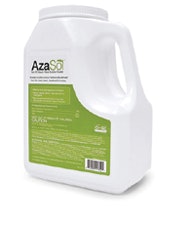Knowing what insecticides are derived from, as well as how they impact pests on your cannabis crops, can boost your cultivation knowledge and help you make the best decisions to keep your plants healthy. Here, Arborjet’s Horticultural Specialist Matt Andrus explains the science behind neem and azadirachtin, and how they can benefit organic production.

1. What is neem derived from?
The word neem refers to a tree called Azadirachta indica. In the gardening world, neem refers to the oil found inside the tree. But the real magic is what’s found inside of neem tree seeds, azadirachtin.
2. What are the benefits of a neem-based solution?
One unique benefit would be the insect growth regulator (IGR) characteristics related to the azadirachtin within the “neem solution.” This IGR quality stops or slows the maturation of insects. This reduces the number of mature insects that can breed and reproduce, eventually leading to a colony collapse. Also, neem works as and antifeedant, anti-ovipositor (slows egg laying capabilities) and an insect repellant. Another interesting benefit to using neem oil is that it can work as a 3-in-1 miticide, insecticide and fungicide for organic production.
3. Why must azadirachtin be present in a neem treatment?

To make the most effective pest management treatment, it is best to increase the number of Modes of Action (MoA). MoA describes how a particular chemistry changes a target pest. Some chemistries smother or asphyxiate, such as horticultural oil. Other chemistries desiccate, like alcohol. Azadirachtin, all by itself, has multiple MoA, making an ideal chemistry to apply for a wide range of pests. If azadirachtin was not in the treatment, you’d be left with fewer MoAs and efficacy would be reduced.
4. Are neem treatments used preventatively or after outbreak?
A preventative treatment will be significantly more effective because adolescent insects are much more susceptible to growth regulation, as opposed to the adults, or mature insects. As insects feed and try to colonize a plant that has been pre-treated with azadirachtin, the egg laying can be reduced. The adolescent insect will not be able to mature to lay eggs. Therapeutic applications after outbreak is common practice and can help you regain control of the crop. If you really want to take full advantage of the IGR qualities then treating preventatively would be my first choice.
5. A product like AzaSol is both translaminar and systemic, what does that mean for an IPM program?
Since AzaSol is 100% soluble, this means that any way you can get water on or in the plant, AzaSol will follow. This makes it a great tool for any IPM program because it will not hurt fresh seedling, cuttings or many other sensitive plant material. Soluble and 6% azadirachtin, AzaSol offers an ideal solution to protect plants when they’re young. If you make your plants undesirable to pests from the start, then you won’t have to battle full-blown colonies with harsh chemical pesticides when your crop is too large to treat efficiently.
















